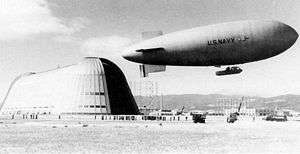J-class blimp
| J class | |
|---|---|
 | |
| Role | Patrol airship |
| Manufacturer | Goodyear-Zeppelin Corporation |
| First flight | 31 August 1922 |
| Retired | 1940 |
| Primary users | US Navy US Army |
| Number built | 2 |
|
| |
The J-class blimps were non-rigid airships designed by the Navy Bureau of Aeronautics and Goodyear Tire & Rubber Company in the early 1920s for the US Navy.
Design and development
Designed in 1919, the J-type were to be improvements upon the D-type. Improvements included a smaller envelope (174,800 cu ft), more powerful engines, a new, simple boat style control car capable of water landings and a single ballonet to reduce weight as tried in the H-1. Two airships, designated J-1 and J-2, were ordered. J-1 first flew 31 August 1922 at Wingfoot Lake. The J-1 was operated at Hampton Roads until airship operations there were terminated in 1924. From May 1924 the J-1 served at Lakehurst, and was at that time the Navy's only active blimp. Due to the single ballonet, the J-1 proved difficult to handle.J-1 was retired in August 1924. J-2 was cancelled due to the failure of the single ballonet J-1, with the car being stored at the Naval Aircraft Factory.
J-3 was assembled from an Army TC type envelope and control car, modified to suit the Navy. Instrumentation came from the J-1. The J-3 first flew 12 October 1926. Lakehurst was the only naval air station which the J-3 served at. Its role was to train crews for the ZR-3 and ZRS-4 and 5. The J-3 was lost during a forced landing while searching for survivors of the dirigible USS Akron (ZRS-4) with the loss of 2 out of its crew of 7.[1] Rescue was made by a United States Coast Guard and New York Police Department amphibians. J-4 utilized the J-2 control car, modified by enclosing it, and a TC-type envelope. It was test flown in November 1927. The J-4 served as a trainer at Lakehurst until it was sent to Sunnyvale in the summer of 1933. After the Army took over Sunnyvale, the J-4 was returned to Lakehurst in May 1935. The J-4 was stricken from the Navy registry in March 1940.
The J-class blimps were equipped with a control car that was suspended externally from the envelope. Utilizing helium for lift, the envelope capacity was 210,000 cu ft (5,900 m3). Two radial engines powered the blimp.
Operators
- United States Army As TC Class Blimps
- United States Navy
Specifications (J-3 and J-4)
General characteristics
- Crew: 5-6
- Length: 196 ft 0 in (59.76 m)
- Diameter: 44 ft 6 in (13.57 m)
- Height: 58 ft 0 in (17.68 m)
- Volume: 210,600 ft3 (5,964 m3)
- Useful lift: 4,600 lb (2,087 kg)
- Powerplant: 1 × Union, 130 hp (97 kW)
Performance
- Maximum speed: 60 mph (96 km/h)
- Cruise speed: 46 mph (74 km/h)
- Range: 970 miles (1,556 km)
- Endurance: 52 hours
- Service ceiling: 8,000 ft (2,439 m)
See also
- Related lists
References
- Shock, James R. (2001). U.S. Navy Airships 1915-1962. Edgewater, Florida: Atlantis Productions. ISBN 0-9639743-8-6.
| ||||||